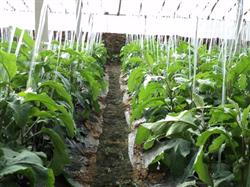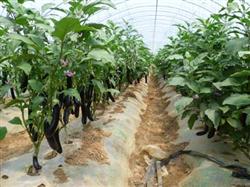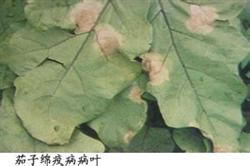Comprehensive techniques of fertilization for eggplant

Eggplant is an annual herb and perennial shrub in the tropics. The root system of eggplant is well developed, the root depth of adult plant is more than 1.5 meters, and the transverse diameter of root system is more than 1 meter. The root system of eggplant cultivated in protected field is mainly distributed in the plough layer of 30 cm. Eggplant root regeneration ability is poor, Lignification is early, so it is not suitable for multiple transplants. The temperature requirement of eggplant is relatively strict, the birth year is slow under 17 ℃, physiological and metabolic disorders are caused by less than 10 ℃, and flowers fall below 15 ℃. The suitable temperature for flower bud differentiation was Bai Dawei 2O ℃-25 ℃ and 15 ℃-20 ℃ at night. When the temperature was low, the flower bud differentiation was delayed, but there were more long-style flowers, on the contrary, under the condition of high temperature, the flower bud differentiation was earlier, but the proportion of middle-style flowers and short-style flowers increased, especially at high night temperature. The suitable temperature for growth and development of eggplant is 22 ℃-30 ℃, 25 ℃-28 ℃ and 16 ℃-20 ℃ at night. 1. The characteristics of fertilizer requirement of eggplant eggplant is a fertilizer-loving crop, and soil condition and fertilization level have great influence on the fruit setting rate of eggplant. When the nutrition condition is good, the falling flower is few, the malnutrition will make the short column flower increase, the floral organ is dysplastic, should not set fruit. In addition, the nutritional status also affects the position of flowering. When the nutrition is sufficient, the branches of the flowering part can expand 4-Mel-5 leaves. When malnourished, few leaves are unfolded and the number of fallen flowers increases. The absorption of nitrogen, phosphorus and potassium by eggplant increased with the extension of growth period. The absorption of nitrogen, phosphorus and potassium at seedling stage was only 0.05%, 0.07% and 0.09% of the total. The amount of nutrient uptake increased gradually in the early flowering stage, and accounted for more than 90% of the whole period from the full fruit stage to the non-fruit stage, of which the full fruit stage accounted for about 2. 3. The requirements of nutrients are different in different growth stages. The fertilizer in the early growth stage is mainly to promote the vegetative growth of plants. With the progress of growth period, the transport of nutrients to flowers and fruits increases. In the full flowering stage, the absorption of nitrogen and potassium increased significantly, during this period, if the nitrogen was insufficient, the flowers developed poorly, the short style flowers increased and the yield decreased. The production of 1000 kg eggplant requires 3.2kg of pure nitrogen, 0.94kg of phosphorus pentoxide and 4.5kg of potassium oxide. The yield of eggplant per mu is 5000 kg, which requires pure helium 12.8 MUE 16 kg, phosphorus pentoxide 3.8 MUE 4.7 kg, and potassium oxide 18 MUE 22.5 kg. 2. Fertilization technology of eggplant L. the quality of nutritious soil in seedling stage of eggplant is higher, and strong seedlings with short internodes, strong stems and well-developed roots can be cultivated only on high-quality nutritious soil. It is generally required to apply 200 kg of rotten sifted organic fertilizer, 5 kg of superphosphate and 1.5 kg of potassium sulfate on an 11-square-meter seedling bed to mix the bed soil with organic fertilizer and chemical fertilizer. If the seedlings are raised with nutritious soil, the organic fertilizer made from the mixture of 4 beat 5 rotten horse manure and 1 pound 5 mature human manure can be added to the vegetable garden soil, and the preparation method of tomato seedling nutrient soil can also be referred to. If you encounter low temperature or insufficient soil fertilizer supply, 0.3% Mel 0.5% urea aqueous solution can be sprayed. In order to effectively prevent and cure the sudden collapse disease, the medicine soil can be covered. The medicinal soil is made of 50% carbendazim or topiramine 8Mel 10g, mixed with 12kg nutritionally. The medicinal soil can be sprinkled on the bed at one time before the seedlings are unearthed, or sprinkled on the bed with 2ther 3 before sowing and on the seeds with 1p3 when sowing. Sometimes the medicine has an inhibitory effect on the root growth of seedlings, once the inhibition occurs, a large number of watering can be alleviated. two。 Basic fertilizer eggplant is easy to be infected with Verticillium wilt, so the protected ground of cultivated eggplant should avoid continuous cropping. If the time between stubble is short, it must be disinfected in protective place. According to the space in the protected area, per cubic meter, 4.0 grams of sulfur, 0.1 grams of 80% dichlorvos, 8.0 grams of sawdust are mixed evenly and ignited, sealed for 24 hours and then released. After disinfection, the protected land was treated with 5000~6O00 kg of mature organic fertilizer per mu, plus 35 kg of superphosphate and 15 kg of potassium sulfate, which were evenly sprinkled on the soil surface and raked into the ploughed soil. 3. Before topdressing eggplant, 5000 kg of organic fertilizer and 25-35 kg of phosphorus fertilizer were applied per mu. When the "door eggplant" reaches the "staring period" (when the ovary expands after fertilization to reveal flowers, etc.), the fruit begins to grow rapidly, and topdressing is carried out for the first time. When 4-5 kg of pure nitrogen was applied per mu (9-11 kg of urea or 20-25 kg of ammonium sulfate), the second topdressing was carried out when the eggplant fruit was enlarged, and when the "four sides fight" began to develop, it was the peak of eggplant to be taken, and the third topdressing was carried out. The amount of topdressing in the first three times is the same, but the amount of topdressing can be halved or no potash fertilizer can be applied.
- Prev

Problems that should be paid attention to in topdressing eggplant in summer
1. Appropriate amount. Eggplant needs the largest amount of nitrogen fertilizer, but in the high temperature season, each application of urea should be controlled within 30 kg per mu, because in the high temperature season, the transformation rate of urea is relatively fast after urea is applied into the soil, and after the plant meets the needs, the excess part will cause loss. Especially sandy soil, the proportion of loss will be greater.
- Next

How to treat eggplant cotton blight
The pathogen of eggplant cotton blight is parasitic Phytophthora melongenae, which is serious under high temperature and humidity conditions. Seedling and large seedling stem base infected early water-stained shape, then dark green or purple brown, disease contraction. Control technology: take the selection of disease-resistant varieties, warm soup soaking, ridge planting, control humidity and other measures to prevent. Early onset with 50...
Related
- Where is it suitable to grow horseradish in China? it is expected to see the middle altitude horseradish in Alishan.
- How to prevent tomato virus disease reasonably? (Control methods included)
- Many people like to plant towel gourd on the balcony. What are the main points of this method and management?
- What crops can chili peppers be mixed with?
- Fertilization techniques and matters needing attention in Tomato
- What are the grafting techniques for peach seedlings in spring?
- Harm and control methods of root swelling disease of Chinese cabbage
- What are the pests of sweet potatoes? How to prevent and cure it?
- Symptoms, causes and Control methods of navel Rot in Tomato
- The cause of "Cucumber rotten bibcock" in Farmers' planting Cucumber and its Control Plan

